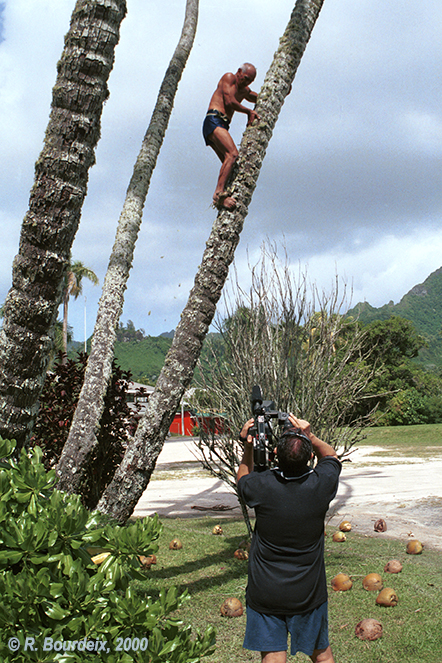In the center of Avarua, capital city of the Cook Islands, just to the east of the traffic circle was a group of seven tall coconut trees growing in circle. Tradition has it that they were from only one tree! These seven palms were finally cut in 2015, at the age of 118 years. But their recent study, conducted after palm's death by R. Bourdeix and V. Mataora, provided interesting and surprising information, that could be useful for assessing new planting devices for the coconut palm.
In 2003, research conducted by Gerald McCormack found three oral traditions, but no early written records. The first tradition links the planting to a criminal trial of June 1911. The second tradition has the unusual coconut obtained by Captain Harries from an outer island – the Captain died in 1918. The third tradition has Henry (Aporo) Williams, Howard Greig and Hagai Paninga assisting on a schooner, said to be Thompson’s, and they brought the 7-sprout coconut from Manuae.
In November 2005, Gerald McCormack happened upon a 1960 article by Miss E. Grant that presents the story of the 7-palms on Rarotonga, as told by Senior Sergeant Nia Rua who was present at the planting. In 1906 and 1907 Howard Greig, Survey cadet, was in charge of gangs planting Conconut Palms on Takūtea. He found a nut with seven shoots and brought it back to Rarotonga in September 1907. The Resident Commissioner, Colonel Gudgeon was so impressed that he had it planted in front of the Administration offices in the presence of all the students of Tereora College, including Nia Rua. So the Seven in One was planted in 1907 or 1908.
 |
| The late "Seven in one" coconut palm, photographed in 2000 at the putative age of 93 years |
But the most surprising was to observed what happened at the base of the stems. The seven bases where remaining, so it was possible to calculate the distance between the palm stems at ground level.
Are coconut palms walking?
Our measurements showed that the average distance between stems at ground level presently ranges from 1.24 to 2.01 m. All the seven sprouts emerged from the same coconut. The old pictures up clearly shows that the stems of the palms were originally well connected. So why, after more than one hundred years, these stems appear separated by an average 1.64 m distance? As far as we know, coconut palms do not walk to get away from each other. Thus this strange observation conducted us to formulate two hypothesis:
- The soil was elevated, during the living palm period, by bringing soil or sand in large quantities, in order to raise an elevation of the ground level of at least 50 cm. There is no historical evidence that such a work was done.
- Due to the heavy weight of the Seven palms planted in a narrow space, and remaining during more than a century, the whole stems and root systems and have progressively sunk 50 cm to 1 m into the ground. In the absence of historical data proving that the human action elevated the soil, this second hypothesis seems the most rationale.
Whatever happen, it resulted in a kind of
six-branched star with a central axis, made of seven coconut stems and buried under
about 50 to 80 cm of soil. Coconut stem keeps the skill to emit roots when in
contact with wet soil. From all parts of this “six-branched star”, roots have
grown and mixed in all directions. This unusual and powerful rooting system
explains both the longevity and the high fruit productivity of the
seven-in-one coconut palms (105 seednuts collected in a single harvest at the
age of 93 years). It could be useful to try to reproduce same kind of stem organization
when testing new planting devices based on palm grouping.
|
Therefore, the Seven-in-one story suggest
that, in such planting devices, the coconut palms from the same group could be
planted at a lower distance than 2 m, which is the spacing presently
recommended in the online video explaining GPH3.
 |
| Fruits of the "Seven in one" coconut palm in 2000 |
 |
| In 2000, Piri Puruto III, the
great coconut climber of Rarotonga, accepted to climb the seven-in-one coconut palms for harvesting seednuts, and the local TV recorded the show |
 |
| These certified-age palms have taught us to recognize the appearance of the trunk of a century-old coconut tree. |
Section DPP-COOK, By R. Bourdeix and V. Mataora, April 2018.


